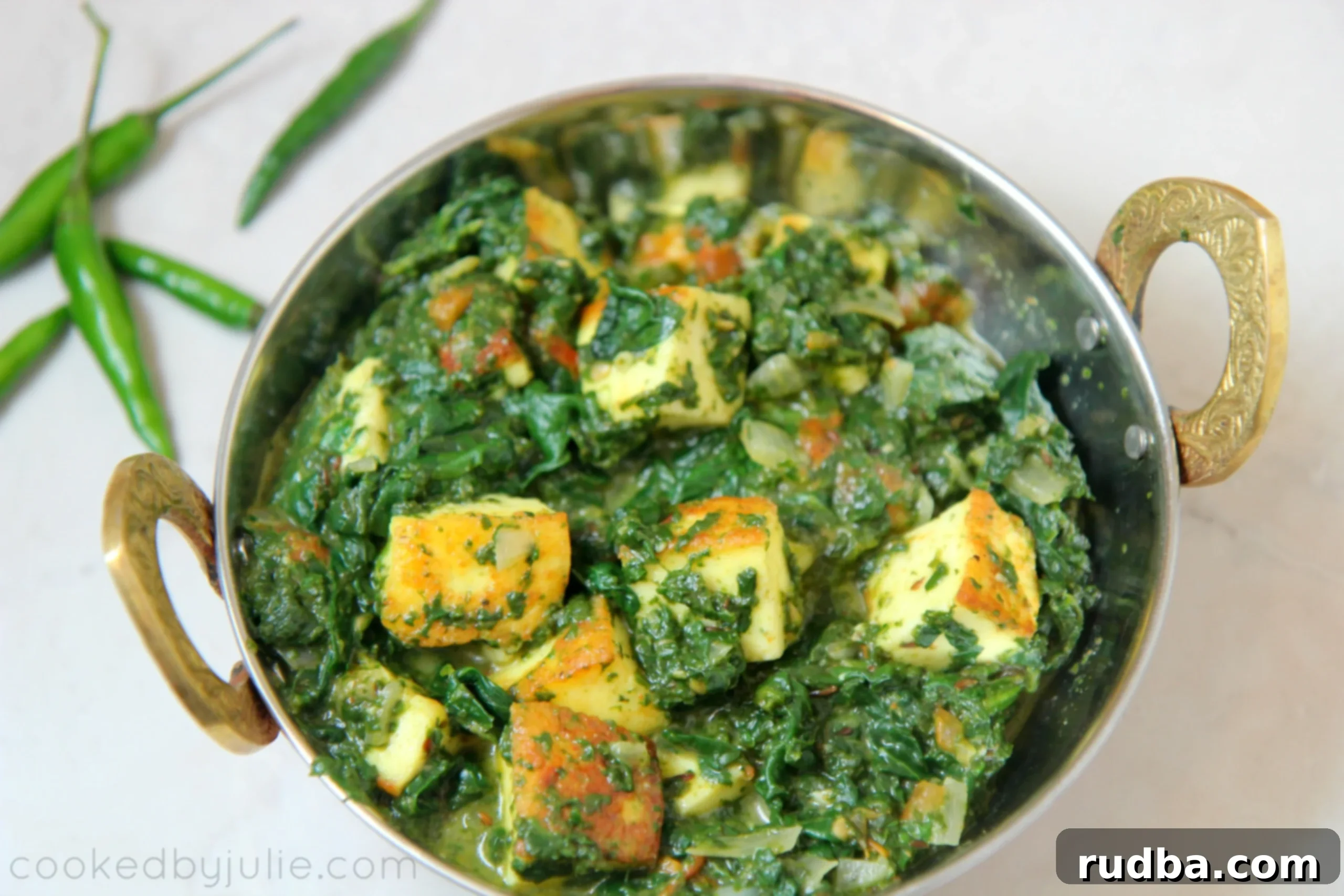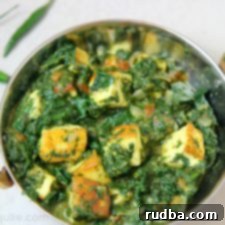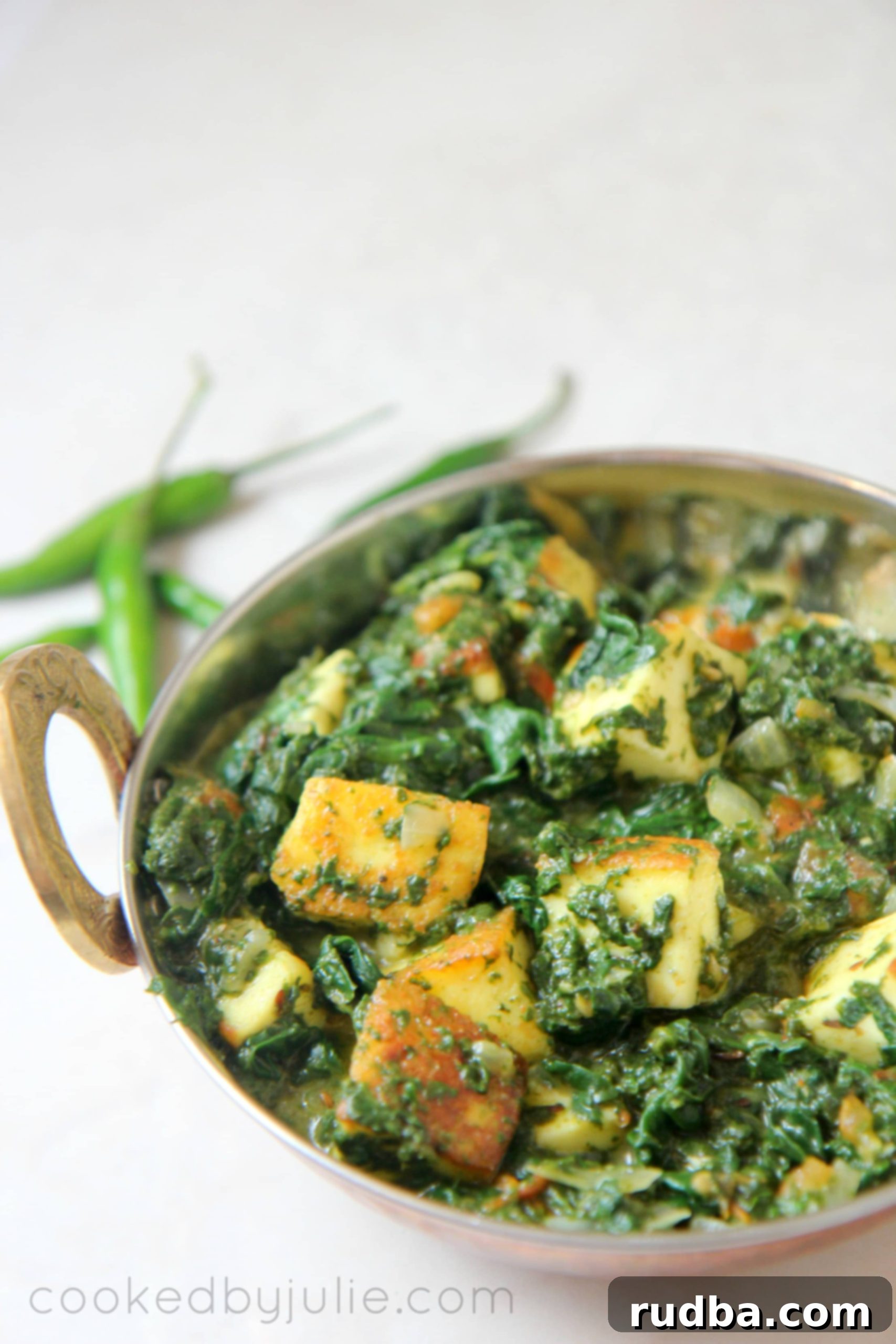Authentic & Easy Saag Paneer Recipe: Your Go-To Keto, Gluten-Free, and Vegetarian Indian Delight
Welcome to the vibrant world of North Indian cuisine! Today, we’re diving into a beloved classic that promises both incredible flavor and nourishing goodness: Saag Paneer. This delightful dish combines tender, spiced creamy greens with succulent cubes of Indian cheese, creating a harmonious blend that’s both comforting and incredibly satisfying. Whether you’re looking for a hearty main course or a flavorful side dish, this super easy and healthy recipe is sure to become a regular in your kitchen.
Saag Paneer stands out as a weeknight favorite for many, and it perfectly complements other Indian classics like Instant Pot Butter Chicken and Spiced Indian Lentils. Its versatility makes it a fantastic addition to any meal rotation, proving that healthy eating can be utterly delicious and deeply flavorful.

Why You’ll Adore This Saag Paneer Recipe
For those who follow my culinary adventures, you know my deep affection for Indian food, particularly its rich tapestry of flavors. Saag Paneer holds a special place, not just for its taste but also for its impressive nutritional profile. This particular recipe is crafted to be Keto-friendly, Gluten-Free, and completely Vegetarian, making it accessible and enjoyable for a wide range of dietary preferences. While I often share indulgent comfort foods like Coconut Chicken Curry, I truly believe in the magic of wholesome, low-carb options that don’t compromise on taste.
One of the best things about Saag Paneer is its incredible adaptability. If you’re following a low-carb or keto diet, serving it with cauliflower rice is an excellent choice. But it’s equally delicious with traditional basmati rice, warm naan bread, or a simple roti. This dish also offers the added bonus of being an exceptional leftover. Many enthusiasts agree that Saag Paneer truly tastes better the next day, as the flavors meld and deepen overnight, creating an even more complex and satisfying experience.
This recipe provides a foundation for a mildly spiced curry, perfect for those who appreciate subtle warmth. However, for those who crave more heat, feel free to enhance it with additional chili powder or fresh green chilies. To add an extra layer of flavor and a beautiful golden hue, I’ve also seasoned the paneer with a touch of turmeric and garam masala before frying – a small step that makes a big difference in the final dish.
What Exactly is Saag Paneer? Understanding the Classic Dish
Saag Paneer is a quintessential North Indian dish, celebrated for its robust flavors and creamy texture. At its heart, it’s a vibrant curry made primarily with leafy greens (saag) and Indian cottage cheese (paneer). While spinach is the most common and traditional green used, the term “saag” broadly refers to any leafy greens, and you might find delicious variations made with mustard greens, fenugreek leaves, or even a mix of greens. The beauty of this dish lies in its flexibility, allowing you to use your favorite leafy vegetables.
Paneer, the star of this dish, is a fresh, non-melting Indian cheese. Unlike many Western cheeses, paneer is unsalted and has a firm, crumbly texture, making it perfect for absorbing the rich flavors of the curry. It’s a fantastic source of protein for vegetarians and is widely available in Indian supermarkets or even larger grocery stores in their international or specialty cheese sections. If you’re feeling adventurous, paneer can also be easily made at home with just milk and a curdling agent like lemon juice or vinegar.
The “saag” component is typically cooked down with a blend of aromatic spices, garlic, ginger, and sometimes onions and tomatoes, creating a rich, earthy, and slightly tangy base. When combined with the mild, creamy paneer, the result is a dish that is both hearty and incredibly flavorful, making it a beloved staple in Indian households and restaurants worldwide.

Essential Ingredients for Perfect Saag Paneer
Crafting the perfect Saag Paneer starts with selecting high-quality ingredients. Here’s a closer look at what you’ll need and why each component is crucial:
- Fresh Spinach: The foundation of our saag. Fresh spinach offers a vibrant color and mild, slightly sweet flavor. Look for crisp, dark green leaves. While fresh is ideal, frozen spinach can also be used (see tips below).
- Paneer: Indian cottage cheese. Its firm texture holds up beautifully in the curry, and its mild flavor readily absorbs the spices.
- Cilantro (Coriander): Adds a fresh, herbaceous note that brightens the entire dish. Used both in the saag base and as a garnish.
- Ginger-Garlic Paste: A classic Indian flavor base, providing pungent and aromatic depth. You can make your own or buy pre-made paste.
- Onion & Tomatoes: These vegetables form the essential aromatic base, adding sweetness, acidity, and body to the curry.
- Green Chilies: For that characteristic subtle (or not-so-subtle!) heat. Adjust the quantity to your preferred spice level.
- Bay Leaf & Cumin Seeds: Whole spices used for tempering (tarka), infusing the oil with warm, earthy aromas at the beginning of the cooking process.
- Garam Masala: A fragrant blend of ground spices, it’s added at different stages to build complex flavors.
- Turmeric: Provides a beautiful golden color and a mild earthy flavor, known for its anti-inflammatory properties.
- Heavy Cream: This is what gives Saag Paneer its signature rich and creamy texture.
- Olive Oil (or Ghee/Neutral Oil): For frying the paneer and sautéing the aromatics. Ghee (clarified butter) would add an even more authentic Indian flavor.
- Salt & Pepper: To season the dish perfectly.
- Lemon Juice (Optional): A squeeze at the end can brighten the flavors, adding a fresh, zesty kick.
How to Make Saag Paneer – A Simple Guide
Making Saag Paneer at home is surprisingly straightforward. Follow these steps to create a delicious and authentic dish that will impress:
- First, prepare your paneer: Drizzle the paneer cubes with 1 tablespoon of olive oil. Season generously with turmeric, salt, pepper, and 1 teaspoon of garam masala. Fry the paneer in a hot skillet over high heat for about 1 minute on each side until golden. Remove from the skillet and set aside. This step adds texture and flavor to the paneer.
- Next, prepare your greens: Bring a pot of water to a rolling boil and salt it generously. Roughly chop your fresh spinach. Add the chopped spinach to the boiling water and cook for just 1-2 minutes until wilted. Immediately drain the spinach completely, squeezing out as much excess water as possible. This prevents a watery saag.
- Create the saag base: Place half of the cooked spinach and fresh coriander (cilantro) into a food processor. Blend until you achieve a smooth puree. This forms the creamy green base of your curry.
- Start the curry: Warm a generous amount of oil (or ghee) in a pan. Add the bay leaf and cumin seeds. Allow the cumin seeds to pop and become fragrant, indicating they’ve infused the oil with their warm, earthy flavor. Stir in the remaining garam masala.
- Build the aromatics: Add the chopped onions, tomatoes, and green chilies to the pan. Cook for 2-3 minutes, stirring occasionally, until the onions become translucent and the tomatoes begin to soften. Stir in the ginger-garlic paste and cook for an additional 30 seconds until fragrant.
- Combine and simmer: Add the pureed spinach and the remaining cooked spinach to the pan. Stir in the fried paneer cubes. Cook everything together for about 2 minutes, allowing the flavors to meld.
- Finish with cream: Pour in the heavy cream and stir well. Season with salt and pepper to taste. If desired, add a squeeze of fresh lemon juice for brightness.
- Gentle simmer: Reduce the heat to medium-low and let the Saag Paneer simmer for 10 minutes, allowing the sauce to thicken slightly and all the spices to fully integrate.
- Serve: Garnish with some fresh, finely chopped coriander (cilantro) if you like. Serve hot and enjoy!
Can You Substitute Fresh Spinach with Frozen Spinach?
Absolutely! Using frozen spinach is a convenient and perfectly acceptable alternative to fresh spinach, especially when fresh isn’t readily available or if you’re looking to save time. However, there’s a crucial step to ensure the best results: you must thaw the frozen spinach completely and squeeze out as much water as possible before adding it to your dish. Frozen spinach contains a lot of moisture, and failing to drain it will result in a watery saag that lacks the desired creamy consistency. Once thawed and drained, proceed with the recipe as directed, blending it into a puree with the fresh coriander.
Top Tips and Creative Recipe Variations:
Making Saag Paneer is a joy, and these tips will help you achieve perfection while offering exciting ways to customize your dish:
- For a Vegan Saag: Easily transform this recipe into a delicious vegan curry. Replace the paneer with chickpeas, firm tofu (pressed and lightly fried), or even your favorite vegetables. Instead of heavy cream, use full-fat coconut milk or a plant-based cooking cream for richness.
- Beyond Paneer: Not a fan of cheese, or simply looking for variety? The spinach base is incredibly versatile! Feel free to throw in your favorite vegetables like sliced mushrooms, corn kernels, diced potatoes, or okra. Cook them until tender before combining with the spinach base.
- Add More Greens: Experiment with a mix of leafy greens! Incorporate mustard greens (sarson), kale, or fenugreek leaves (methi) alongside or instead of spinach for a more complex “saag” flavor. Just ensure all greens are properly cooked and drained.
- Smoky Flavor: For a subtle smoky depth, consider grilling or pan-frying your paneer until it develops a nice char before adding it to the curry.
- Spice Level Adjustment: To increase the heat, add more green chilies or a pinch of red chili powder along with the other spices. For a milder version, reduce the amount of green chilies or remove the seeds.
- Creaminess Factor: If you desire an even richer Saag Paneer, you can slightly increase the amount of heavy cream, or stir in a tablespoon of butter or ghee at the very end.
- Blanching Greens: Blanching the spinach quickly and shocking it in ice water (though not explicitly in this recipe’s steps, it’s a general tip) helps retain its vibrant green color, though a quick boil as instructed is usually sufficient for this dish.
Serving Suggestions for Saag Paneer
Saag Paneer is incredibly versatile and pairs wonderfully with a variety of accompaniments. Here are some ideas to complete your meal:
- Traditional Breads: Serve it with warm naan, roti, paratha, or even simple chapati to scoop up the flavorful curry.
- Rice: Classic basmati rice, jeera rice (cumin rice), or brown rice are excellent choices.
- Low-Carb Options: As mentioned, cauliflower rice is a fantastic keto-friendly alternative. You can also enjoy it with steamed vegetables or a simple side salad.
- Dal: Pair it with a bowl of comforting dal (lentil curry) for a wholesome vegetarian feast.
- Yogurt or Raita: A dollop of plain yogurt or a cooling cucumber raita can balance the richness and spices of the Saag Paneer.
Storage and Reheating Made Easy
One of the many joys of Saag Paneer is how well it keeps, often tasting even better the next day! Here’s how to store and reheat your leftovers:
- Storage: Allow the Saag Paneer to cool completely before transferring it to an airtight container. It can be stored in the refrigerator for up to 3-4 days.
- Freezing: Saag Paneer freezes beautifully. Place cooled curry in freezer-safe containers or heavy-duty freezer bags. It can be frozen for up to 2-3 months. Thaw overnight in the refrigerator before reheating.
- Reheating: For best results, reheat Saag Paneer gently on the stovetop over medium-low heat, stirring occasionally, until heated through. You may need to add a splash of water or milk to loosen the consistency, as it can thicken in the refrigerator. Alternatively, you can reheat individual portions in the microwave, stirring halfway through.
Explore More Indian Inspired Recipes:
If you’ve enjoyed this Saag Paneer, be sure to check out these other delicious Indian-inspired recipes from my kitchen:
- Paneer Salad – A refreshing twist featuring everyone’s favorite Indian cheese.
- Instant Pot Butter Chicken – For a quick and comforting non-vegetarian option.
- Spiced Indian Lentils – A wholesome and flavorful vegetarian staple.
- Coconut Chicken Curry – Another creamy, aromatic curry that’s a crowd-pleaser.

Saag Paneer – Keto Friendly, Gluten-Free, Vegetarian
Save RecipeSaved Recipe
Pin Recipe
Rate Recipe
Print Recipe
Ingredients
- 16 ounces spinach
- 14 ounces paneer
- 1 small bunch cilantro
- 1 tbsp ginger garlic paste
- 1 small onion
- 2 tomatoes
- 2 green chilies
- 1 bay leave
- 1 tsp cumin seeds
- 1 tbsp garam masala
- 1/4 tsp turmeric
- 3 tbsp heavy cream
- 1 tbsp olive oil
- salt and pepper to taste
Instructions
-
Bring a pot of water to a boil and salt it generously.
-
Drizzle the paneer with 1 tbsp olive oil.
-
Season the paneer with turmeric, salt, pepper, and 1 tsp garam masala.
-
Fry the paneer over high heat for 1 minute on each side.
-
Remove the fried paneer from the skillet and set aside.
-
Roughly chop spinach.
-
Add the spinach to the boiling water and cook for 1-2 minutes, drain completely.
-
Place half of the spinach and coriander in a food processor and blend until pureed.
-
Warm-up some oil in a pan.
-
Add the bay leave and cumin seeds, let the cumin seeds pop.
-
Stir in the remaining garam masala.
-
Add the onions, tomatoes, and green chilies for 2-3 minutes or until translucent.
-
Add the ginger-garlic paste and cook for an additional 30 seconds.
-
Stir in the spinach and paneer and cook for 2 minutes.
-
Add the heavy cream.
-
Season with salt and pepper and simmer over medium-low heat for 10 minutes.
-
Enjoy!
Video
Notes
Nutrition
Nutrition information is automatically calculated, so should only be used as an approximation.
Additional Info
Like this recipe? Leave a comment below!
Frequently Asked Questions About Saag Paneer
Here are some common questions about making and enjoying Saag Paneer:
- Is Saag Paneer healthy?
- Yes, Saag Paneer is generally considered a very healthy dish. Spinach is packed with vitamins (A, C, K), minerals, and antioxidants, while paneer provides a good source of protein and calcium. When prepared with moderate amounts of oil and cream, it can be a nutritious and balanced meal.
- Can I make Saag Paneer without cream?
- You can certainly make a lighter version of Saag Paneer without heavy cream. For a creamy texture, you can substitute heavy cream with a splash of milk, cashew cream (blended cashews and water), or coconut milk (for a vegan option). The flavor profile will change slightly, but it will still be delicious.
- What is the difference between Palak Paneer and Saag Paneer?
- While often used interchangeably, there is a subtle difference. Palak Paneer specifically refers to a dish made with spinach (palak) and paneer. Saag Paneer, on the other hand, is a broader term where “saag” can refer to any leafy greens, including spinach, mustard greens (sarson), fenugreek leaves (methi), or a combination of them. So, Palak Paneer is a type of Saag Paneer.
- How do I prevent my Saag Paneer from becoming watery?
- The key to preventing a watery saag is to thoroughly drain and squeeze out as much excess water from the cooked spinach as possible. If using frozen spinach, ensure it’s completely thawed and squeezed dry. Don’t add too much additional water during the cooking process.
- Can I prepare the spinach puree in advance?
- Yes, you can blanch and puree the spinach a day or two in advance and store it in an airtight container in the refrigerator. This can save you time on busy weeknights, making the final preparation even quicker.
Final Thoughts on This Delightful Indian Dish
Saag Paneer is more than just a meal; it’s a culinary journey to the heart of North India, offering a beautiful balance of flavors, textures, and nutrition. Its ease of preparation, adaptability, and comforting qualities make it an ideal choice for both seasoned cooks and those new to Indian cuisine. Whether you’re adhering to a specific diet like keto or gluten-free, or simply looking for a wholesome and incredibly tasty vegetarian option, this Saag Paneer recipe delivers every time. I encourage you to try it, savor the rich aromas, and enjoy the satisfaction of creating an authentic Indian classic right in your own kitchen. Don’t forget to share your experience and any creative twists you add in the comments below!
